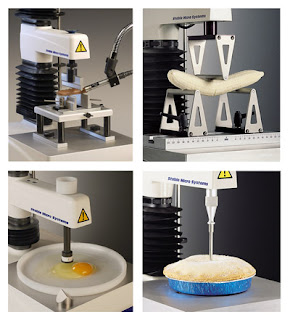Our customers around the world may be surprised to find some items here that aren’t so different from their own national food.
The first component of afternoon tea is a large, fluffy scone, cut in half and spread with sticky jam and clotted cream. There are regional arguments for whether jam or cream should be applied first, but in both cases cream and jam that are hard and difficult to spread cause the scone to break up under the knife, which is very undesirable. The softness of the inside of a scone can be assessed by preparing a cubic sample, having cut the crusts off, and performing a compression test with a large cylinder probe. A soft sample will yield under a low force.
The properties of jam and clotted cream are both temperature-dependent, so it is particularly important to consider this when testing these products – the consumer will most likely use them straight after removing them from the fridge.
 |
| • Peltier Cabinet • Spreadability Rig • VolScan Profiler • Kramer Shear Cell |
Secondly, elegant finger sandwiches with their crusts cut off are a vital component of afternoon tea. These are often filled with smoked salmon, cucumber or egg and cress. As afternoon tea is a dainty affair, bread that feels heavy in the hand and dense in the mouth is not desirable. The VolScan Profiler by Stable Micro Systems is very helpful here, giving accurate volume and density measurements.
Smoked salmon must be tender when bitten so it is easy to take a bite of the sandwich without the rest of the filling pulling out from the bread remaining in your hand. The maximum force measured from a test in the 5-bladed Kramer Shear Cell is a useful way of measuring this inhomogeneous product in bulk.
 |
| • Acoustic Envelope Detector • 3 Point Bend Rig • Egg Testing System • Cylinder Probe |
Finally, afternoon tea would be lost without a delicious piece of cake. French fancies are a typical choice – a soft sponge topped with buttercream and coated in a thin layer of icing. These three layers provide an interesting combination of textures when the cake is bitten into. A slow penetration test with a 5mm Cylinder Probe would discriminate between the different layers. The outer icing is crisp, the buttercream is soft and plastic, and the sponge is soft and springy. These characteristics would be distinguished as differing curve shapes on a force-displacement graph.
Contact Stable Micro Systems today to discover innovative testing methods for your texture needs.
We can design and manufacture probes or fixtures for the TA.XTplus texture analyser that are bespoke to your sample and its specific measurement.
Once your measurement is performed, our expertise in its graphical interpretation is unparalleled. Not only can we develop the most suitable and accurate method for the testing of your sample, but we can also prepare analysis procedures that obtain the desired parameters from your curve and drop them into a spreadsheet or report designed around your requirements.
For more information on how to measure texture, please visit the Texture Analysis Properties section on our website.
 The TA.XTplus texture analyser is part of a family of texture analysis instruments and equipment from Stable Micro Systems. An extensive portfolio of specialist attachments is
available to measure and analyse the textural properties of a huge range of
food products. Our technical experts
can also custom design instrument fixtures according to individual
specifications.
The TA.XTplus texture analyser is part of a family of texture analysis instruments and equipment from Stable Micro Systems. An extensive portfolio of specialist attachments is
available to measure and analyse the textural properties of a huge range of
food products. Our technical experts
can also custom design instrument fixtures according to individual
specifications.No-one understands texture analysis like we do!
To discuss your specific test requirements click here...
 |  |  |


No comments:
Post a Comment